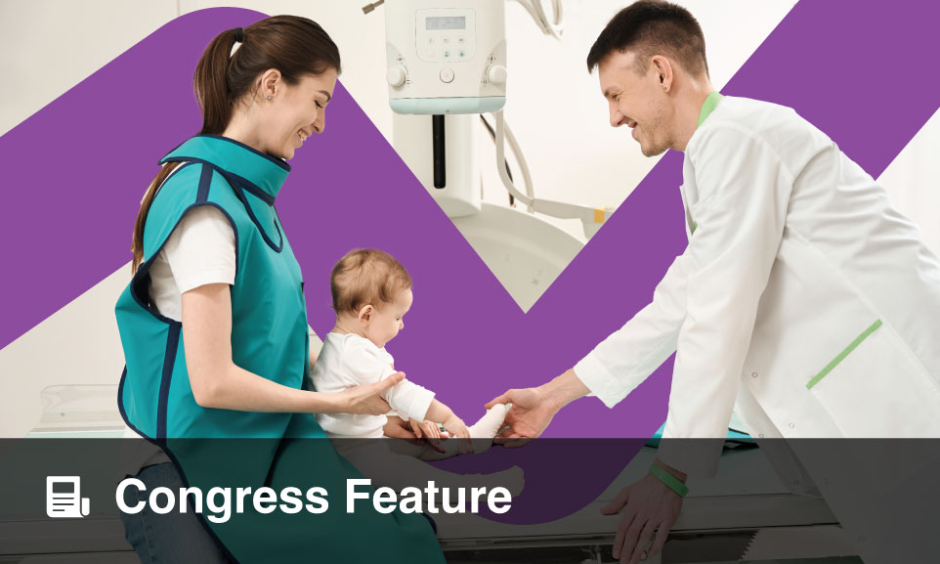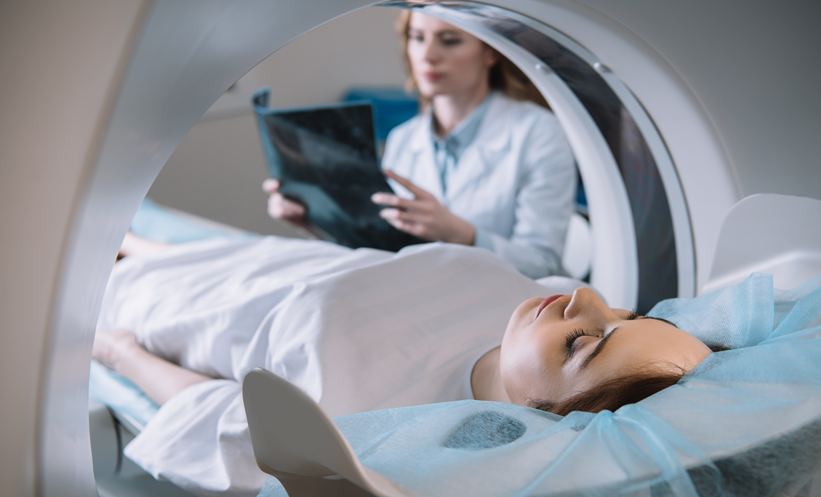Evgenia Koutsouki: | Editor
Citation: EMJ. 2023;8[1]:10-14. DOI/10.33590/emj/10308469. https://doi.org/10.33590/emj/10308469.
![]()
Radiation Safety in Paediatric CT
When introducing the main risks involved in paediatric CT, Magdalena Maria Woźniak, Medical University of Lublin, Poland, explained that these include the risk of radiation, the risk linked to sedation, and the risk of use of contrast media, but that a lot can be done to reduce the risk of radiation,as many factors can be controlled by the radiologist.
Special attention needs to be given to the justification and optimisation of CT procedures in children, Woźniak explained, as the radiosensitivity of organs and the distribution of radiosensitive tissue differ in comparison to adults. However, the actual risk of developing cancer is still difficult to assess, meaning it is important to ensure that the radiation dose used does not exceed the necessary dose for an image of adequate diagnostic quality.
In terms of justification, Woźniak explained the importance of considering other imaging modalities, which do not involve ionising radiation, and for the radiologist to review every referral, ensuring criteria are met beforedeciding on the protocol and modalityto be followed.
When optimising the procedures involved, there are a few factors to be considered. Woźniak emphasised the importance of keeping the patient immobilised, as this helps obtain a better image quality, thus reducing the risk of radiation intake. Using equipment specially designed for children is key, especially in facilities with a large population of paediatric patients, as is usage of pre-installed protocols for standard examinations tailored to paediatric patients. Woźniak also highlighted the importance of determining the used scan’s field of view to cover the whole patient, thus avoiding artefacts, versus the smaller diagnostic field of view. When performing a scan, one should aim for the least acquisitions possible and the most reconstructions possible. The use of new technologies, including tube current modulation, organ based tube current modulation, automatic kilovolt selection, and adaptive collimation, can go a long way in reducing theradiation dose.
Woźniak concluded her talk by emphasising that the referrals for paediatric CT should be evaluated beforehand for justification and procedure optimisation. Furthermore, protocols should be adapted according to patient size and not age, except for brain CTs, and should take into consideration the clinical tasks. Looking into the future, with the progress in medical X-ray technology, alongside the commitment of manufacturers to continued innovation, there is high potential for high dose reduction.
The Pros and Cons of Shielding
In discussing the benefits of shielding in children, Rutger Jan A.J. Nievelstein, University Medical Center Utrecht, the Netherlands, explained that this is used in order to reduce the stochasticeffects of radiation as well as its deterministic effects, such as skin erythema and cataract.
When thinking about shielding, Nievelstein explained it is important to consider factors such as obscure pathologies or anatomic structures, incorrect placement due to anatomic variations, interference with automatic exposure control systems, and beam hardening and streak artefacts, which can occur especially in CT.
A 2012 study1 demonstrated that gonad shielding was placed incorrectly in 91% of females and 66% of males in pelvic radiographs of children aged 0–15 years. Given that the dose of pelvic radiograph is very low and the genetic risk without shielding is also very low, the risk reduction with shielding was calculated to be only 6% for females and 24% for males. According to the study, shielding does not add anything for risk reduction to the child and it is best left out, as when shielding is not done properly it increases the risk of retakes, which will actually increase the dose to the child. In fact, based on the European Consensus recommendation published in 2021, shielding is not recommended in any indications, except maybe in dental cone beam CT.
Exploring dose reduction strategies for conventional radiography and fluoroscopy, Nievelstein explained that good collimation, posterior anterior positioning, and removal of anti-scatter grids, especially in children under 12 years of age, are important.In radiography, focus-film distance that is as large as possible, use of filtration when applicable to remove the low energy radiation, and preferably avoiding usage of automatic exposure are also important. In fluoroscopy, factors to consider are increasing X-ray to skin distance, minimising the magnification, using image grabs instead of radiographs, and using pulsed fluoroscopy adapting pulse rate to indication, preferably using as low a frame rate as possible.
In his concluding remarks, Nievelstein explained that shielding inside and outside the field of view is not recommended in almost all indications, and optimisation of technique and operator parameters in computed radiography and fluoroscopy are more efficient as a strategy for dose reduction. Nievelstein emphasised that using the European Diagnostic reference levels for a daily practice already results in very low doses of ionising radiation in computed radiography and fluoroscopy in children; however, there is room for further optimisation of these, as they are median values of doses used in different countries across Europe.
Risks of Ultrasound in Children
In discussing the risks associated with ultrasound (US), Michael Riccabona, LKH University Hospital Graz, Austria, explained that the sound energy applied to the body during US might have both a mechanical impact on the body and thermal effects caused by molecular motion. The use of contrast agents also has risks associated with it. Unlike radiation, there is no stochastic effect in US and, therefore, the risk correlates to the amount of energy used, which can be managed by observing the output of the device. The energy output can be displayed on screen expressed as Watts, as a percentage of maximum output, as mechanic index, or asthermal index.
Quoting the European Federation of Societies for Ultrasound in Medicine and Biology (EFSUMB) guidelines, Riccabona explained that “diagnostic US can only be safe if used prudently and performed by trained and competent personnel.” In explaining the risks of various US methods, Riccabona explained that harmonic imaging possibly has a higher mechanical index, whereas doppler involves more tissue heating and thus higher thermal index. Specifically, doppler applications need high intensities to obtain strong echoesfrom poorly reflecting blood cells forflow studies.
With contrast enhanced US there are cavitation risks, even at relatively low mechanical index, and, finally, with elastography it is probable that more energy is used due to the stronger and longer acoustic pulse sequence. Riccabona emphasised the importance of observing the as low as reasonably possible (ALARA) principle, particularly in vulnerable organs and patient groups.
Ricabona also discussedthe importance of cleaning and disinfecting to reduce the risk of viral and bacterial contamination, as well as the risk of nosocomial transmission of pathogens or cross infections between patients. Among items and areas that might require cleaning are the transducers, examiner’s hands, investigation table, and keyboard. However, Ricabona emphasised that it is important to be careful about negative interaction with the transducer material, as disinfectant may destroy the surface, alter or impair imaging performance, and cause damage to the materials, or make the transducer electrically unsafe.
Mitigating the risks of paediatric MRI
Ruth O’Gorman Tuura, Center for MR Research, University Children’s Hospital Zurich, Switzerland, discussed safety in paediatric MRI. O’Gorman Tuura explained that the actual level of risk might differ between children and adults, not only due to differences in physiology, but also due to procedural differences, such as the involvement of additional staff, the presence of parents in scans, and difficulties with patient screening.
In MRI, the sources of risk arise fromthe static magnetic field, the radiofrequency pulses to excite the signal, and the time-varying magnetic field gradients used. Each of the magnets has projectile effects, and radiofrequency might cause heating of tissue and potential burns. Finally, peripheral nerve stimulation, acoustic noise, and interaction with devices are risks of the magnetic field gradients.
O’Gorman Tuura emphasised the importance of having local safety policies in place, and implementing access control to make sure that people without magnetic resonance (MR) training are not able to access the area to mitigate the magnetic field risk. It is also important to have adequate staff training, with clear roles and responsibilities outlined. She recommended always referring to national and international guidelines to stay informed and educated.
The most frequently reported adverse events arising from radiofrequency are the result of skin-to-skin contact or contact with the scanner bore radiofrequency coil. The ways to mitigate these are through specific absorption rate management; avoiding skin-to-skin contact and small points of skin contact; avoiding contact with the bore, ECG leads, or other electrically conductive objects; and using insulating pads. Changing patients into hospital provided gowns with no microfibres is also key in mitigating risk.
In children, due to differences in size, water content, and electrical properties, compared to adults, heat deposition and dissipation are altered, particularly in young children and neonates. Accurate estimation of heating depends on knowledge of child-specific parameters. In a simulation study investigating heating in neonates, additional hotspots were observed with child-specific values, meaning that heating risk is altered in children, particularly in neonates compared to adults. Cooling is also a concern, especially in neonates where the incubator temperature has been found to have dropped after scans, so excessively long scans canbe problematic.
In terms of time varying gradient field risks, the magnitude of the switched gradient fields increases with distance from the isocentre, suggesting that the risk is smaller for children than adults. Adverse health effects have been linked to excessive sound pressure in preterm neonates. Neonatal earmuffs in combination with earplugs can reduce noise significantly.
Procedural challenges include the need for sedation in children, meaning that additional personnel and equipment are in the room and that there is no feedback available during the scan. In addition, parents may need to accompany unsedated children, meaning that procedures need to be put in place to screen the parents and document their answers to questions. Finally, teenagers might need double screening, with and without a parent, and there is an increased risk of foreign bodies.
In terms of solutions, O’Gorman Tuura explained that anaesthesia for neonates might not be necessary, as sedation can be done under natural sleep using the feed and wrap method. For older children, regular training for all staff involved in MRI is essential, but specific training for the anaesthesia team for practicing emergency procedures in the room is essential, as is building a strong safety culture.
In the final part of her talk, O’Gorman Tuura went through the procedures for imaging in people with implants. She highlighted the importance of looking for the MR label of safety in implants, confirming the model of implant from patient notes, looking up the latest guidelines from the implant manufacturers, and following MR conditional labelling. O’Gorman Tuura also explained that for cardiac implantable electronics a decided risk benefit analysis needs to be carried out, and there need to be defined responsibilities and procedures for monitoring the patient during the scan. For unlabelled implants for MR safety, O’Gorman Tuura emphasised the importance of assuming it is unsafe but gathering as much information as possible to assess the risk and carrying out a risk benefit analysis by the supervising radiologist.








